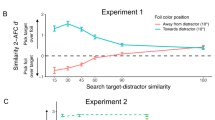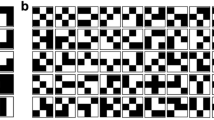Abstract
It is commonly assumed that certain features are so elementary to the visual system that they require no attentional resources to be perceived. Such ‘preattentive’ features are traditionally identified by visual search performance1,2,3, in which the reaction time for detecting a feature difference against a set of distractor items does not increase with the number of distractors. This suggests an unlimited capacity for the perception of such features. We provide evidence to the contrary, demonstrating that detection of differences in a simple feature such as orientation is severely impaired by additionally imposing an attentionally demanding rapid serial visual presentation task involving letter identification. The same visual stimuli exhibit non-increasing reaction time versus set-size functions. These results demonstrate that attention can be critical even for the detection of so-called ‘preattentive’ features.
This is a preview of subscription content, access via your institution
Access options
Subscribe to this journal
Receive 51 print issues and online access
$199.00 per year
only $3.90 per issue
Buy this article
- Purchase on Springer Link
- Instant access to full article PDF
Prices may be subject to local taxes which are calculated during checkout





Similar content being viewed by others
References
Treisman, A. M. Preattentive processing in vision. Comput. Vis. Graph. Image Proc. 31, 156–177 (1985).
Treisman, A. M. & Sato, S. Conjunction search revisited. J. Exp. Psychol.: Hum. Percept. Perf. 16, 459–478 (1990).
Wolfe, J. M. Guided search 2.0: A revised model of visual search. Psychonom. Bull. Rev. 1, 202–238 (1994).
Neisser, U. Cognitive Psychology(Appleton-Century-Crofts, New York, (1967)).
Julesz, B. Textons, The elements of texture perception, and their interactions. Nature 290, 91–97 (1981).
Julesz, B.. & Bergen, J. R. Textons, the fundamental elements in preattentive vision and perception of textures. Bell Sys. Tech. J. 62, 1619–1645 (1983).
Hubel, D. H. & Wiesel, T. N. Receptive fields and functional architecture of monkey striate cortex. J. Physiol. (Lond.) 195, 215–243 (1968).
Knierim, J. J. & Van Essen, D. C. Neuronal responses to static texture patterns in area V1 of the alert macaque monkey. J. Neurophys. 67, 961–980 (1992).
Raymond, J., Shapiro, K. & Arnell, K. M. Temporary suppression of visual processing in an RSVP task: an additional blink? J. Exp. Psychol.: Hum. Percept. Perf. 18, 849–860 (1992).
Duncan, J., Ward, R. & Shapiro, K. Direct measurement of attentional dwell time in human vision. Nature 369, 313–315 (1994).
Chun, M. M. & Potter, M. C. Atwo-stage model for multiple target detection in rapid series visual presentation. J. Exp. Psychol.: Hum. Percept. Perf. 21, 109–127 (1995).
Braun, J. & Sagi, D. Vision outside the focus of attention. Percept. Psychophys. 48, 45–58 (1990).
Braun, J. & Sagi, D. Texture-based tasks are little affected by second tasks requiring peripheral or central attentive fixation. Perception 20, 483–500 (1991).
Braun, J. Visual search among items of different salience: Removal of visual attention mimics a lesion in extrastriate area V4. J. Neurosci. 14, 554–567 (1994).
Norman, D. A. & Bobrow, D. G. On data-limited and resource-limited processes. Cogn. Psychol. 7, 44–64 (1975).
Mack, A., Tang, B., Tuma, R., Kahn, S. & Rock, I. Perceptual organization and attention. Cogn. Psychol. 24, 475–501 (1992).
Rock, I., Linnett, C. M., Grant, P. & Mack, A. Perception without attention: results of a new method. Cogn. Psychol. 24, 502–534 (1992).
Acknowledgements
This work was supported by the University of Nevada, Reno College of Arts and Science (J.S.J.), NIH (J.S.J., M.M.C.), and AFOSR (K.N.) and the McKnight Foundation (K.N.). We thank P. Cavanagh and J. M. Wolfe for helpful comments on the manuscript.
Author information
Authors and Affiliations
Corresponding author
Rights and permissions
About this article
Cite this article
Joseph, J., Chun, M. & Nakayama, K. Attentional requirements in a ‘preattentive’ feature search task. Nature 387, 805–807 (1997). https://doi.org/10.1038/42940
Received:
Accepted:
Issue Date:
DOI: https://doi.org/10.1038/42940
This article is cited by
-
Visual working memory directly alters perception
Nature Human Behaviour (2019)
-
Shape perception enhances perceived contrast: evidence for excitatory predictive feedback?
Scientific Reports (2016)
-
Information processing bottlenecks in macaque posterior parietal cortex: an attentional blink?
Experimental Brain Research (2013)
-
Task set flexibility and feature specificity modulate the limits of temporal attention
Psychological Research (2013)
-
Allocation of attention for dissociated visual and motor goals
Experimental Brain Research (2013)
Comments
By submitting a comment you agree to abide by our Terms and Community Guidelines. If you find something abusive or that does not comply with our terms or guidelines please flag it as inappropriate.



